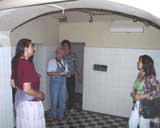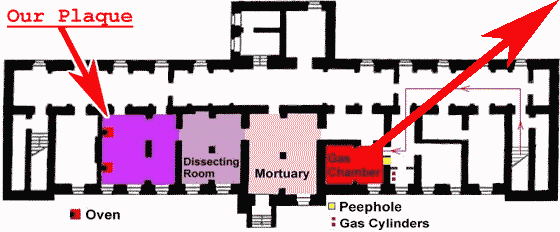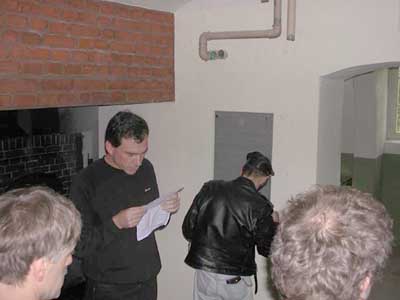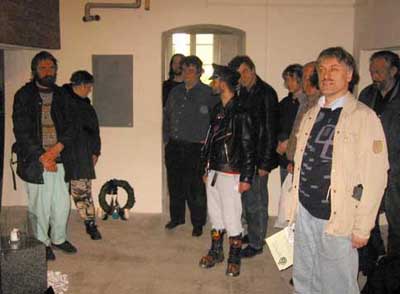This
2nd of May is the 6th anniversary of the Verdict of the Foucault
Tribunal, where for the first time psychiatry was put on a public trial
by those it persecuted.
The
idea to devote a day to Remembrance and Resistance
which was first initiated in Berlin, became later a national event and since
last year it was taken up by groups world wide.
Today we are here in the memorial site of the Bernburg
psychiatric institution, Germany, next to the gas shower. This is one
of the six psychiatric institutions where in 1940 the killing factory by
German medical doctors began.
From
1940 - 1941 groups of psychiatric prisoners from various institutions, and
from 1941 until 1943 groups of jews from concentrations camps who were selected
by medical professionals, were brought to this hospital to be exterminated.
The
medical doctors were the missing link between psychiatric discrimination
and racial ideology to the genocide
from 1939 to 1948. This was a radical biologicalization of politics:
the denying of the legal status of "human being" from certain
groups in society based on medical-biological grounds. The aim of the medical
doctors was to cut off any future of their victims, first in a violent penetration
into the body by forced
sterilization and humiliating them by declaring them "biologically
unfit", and than accelerating the process by mass murder in gas showers.
Our
aim in this event is to use memory as an active tool in constructing the
moral of oppressed groups in their struggle for regaining human rights and
human dignity, and by that to forge a link between us, living human rights
activists, and the murdered victims of psychiatry.
If
memory should be allowed to be used only as an obscene peephole into a chamber
of horror it will serve to hide the guilt of the perpetrators and the continuing
denial of the victims dignity. This "remembrance serves in order to
forget".
We
ask for five minutes of silence.
Berlin:
May 2, 2004. In memory of the medical mass murder in Germany under National
Socialism, a bouquet of flowers was laid on the T4 memorial placque and
a minute of silence was held.
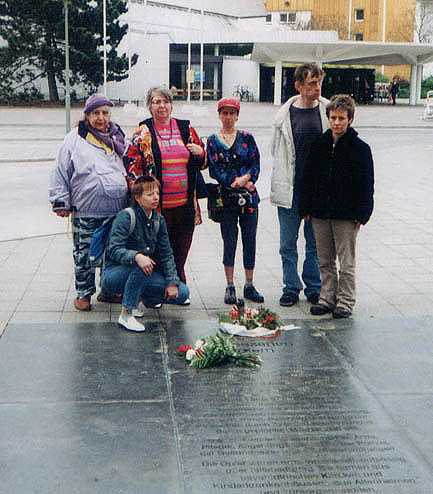

Toronto:
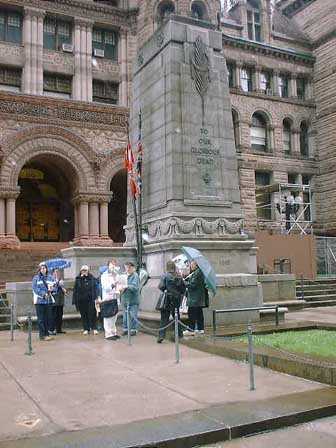
Photo:
Graeme Becque
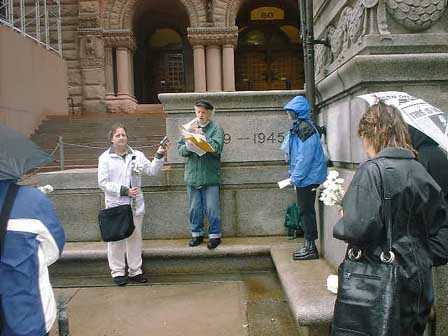
Photo:
Graeme Becque
The memorial in
Toronto for the victims of eugenic mass murder in Germany, was very simple
and well attended, considering the weather and short notice. Even though
it was blustery and had been raining heavily all morning, there were 14
people there. This included several people whom Ididn't know before, but
who had heard about the event through email and public announcements, as
well as a passerby who stopped and joined us in remembering our brothers
and sisters who were murdered because of their
diagnostic label.
The Toronto event
was held in front of the Cenotaph in downtown Toronto at Old City Hall,
which is where the November 11 Remembrance Day events are always held every
year. Fortunately, the rain was in between downpours when our memorial was
held. Graeme took photos of the event and Don brought his tape recorder
to preserve it on tape.
Shortly after 12
Noon the memorial began with the reading of the statement which the International
Association Against Psychiatric Assault composed and plans to have placed
next to the Bernburg killing centre in Germany. Then, the statement which
members of Psychiatric Survivor Archives, Toronto composed and approved
for this memorial was read out. (It was posted on this list-serve on April
23.) Copies of the PSAT statement were handed out to participants and to
a few passersby. A minute of silence was observed at
the conclusion of this statement. Then, white carnations and daisy flowers
were placed below the stone cenotaph inscription "1939-1945".
The statement below,
written by two members of Psychiatric Survivor Archives-Toronto
PSAT Statement for
the International Commemoration for the Victims of Eugenic Mass Murder Toronto
May 2, 2004, 12:00 noon in front of Old City Hall, War Cenotaph
"Well, are
you again looking for new victims, you mass murderers?" These words
were spoken by a female psychiatric patient to a group of doctors who were
involved in the eugenic mass murder campaign in Nazi Germany between 1939-1945.
At Noon on May 2, 2004 there will be a gathering in Toronto in front of
the Cenotaph at Old City Hall in downtown Toronto as part of the International
Commemoration of the Victims of Eugenic Mass Murder. This memorial is taking
place in Germany, Holland, Chicago and Toronto to remember those people
who perished because of their diagnostic label in a society which viewed
them with contempt. We will gather to remember these victims of eugenics
policies and urge vigilance against the poisonous hatred that gave rise
to their murders, malignant ideas which did not die with the Third Reich.
Between 1939-45,
at least 200,000 men, women and children were murdered due to eugenic policies
first promoted by medical professionals who received the active support
of the of the German state. The victims were psychiatric patients and people
with developmental and physical disabilities.
Ideas, which led
to this barbaric eugenics policy, did not originate in the mind of Adolf
Hitler. Instead, he supported what others had been promoting long before
his assumption of power. Doctors and political activists on both the left
and right in Germany, the United States and Canada, among other countries,
publicly supported the forcible sterilization and, in some cases, outright
murder, of people with disabilities. Leading psychiatrists, such as Canadian
C.K. Clarke (1857-1924), expressed their support for eugenics long before
the Nazi period saw the most draconian application of these ideas anywhere
in the world. Indeed, in 1942, after the eugenic mass
murders had commenced and became known inside and outside of Germany, the
"American Journal of Psychiatry" published the views of psychiatrist
Foster Kennedy who advocated the murder of so-called "defective"
children. In an editorial, the APA journal fully supported his murderous
ideas. By this time, eugenics practices had a long history outside of Germany.
Legislation, first
in Indiana in 1907 and eventually in 30 states, saw the passing of sterilization
laws with at least 60,000 victims in the United States over the next six
decades. Alberta (1928) and British Columbia (1933) also passed eugenics
laws with approximately 3,000 people sterilized in both provinces combined,
by the early 1970s. Eugenic mass murder did not take place in North America
as it did in Nazi Germany. But the ideas, which led to the killings in Germany,
had, as its inspiration, the writings and legal advocacy of leading members
of the medical, judicial and political elite in North America and Germany
long before the Nazis came to power.
Psychiatrists, especially
professors of psychiatry and psychiatric department heads, played leading
roles in planning and dministering the eugenic mass murder program. The
first people targeted in the systematic mass killing of specific groups
of people under Hitler were disabled children and psychiatric patients.
Most victims were murdered in 6 German-psychiatric "killing centres":
Hadamar, Hartheim, Grafenek. Sonnenstein, Brandenburg, and Bernburg. The
method of killing in Nazi Germany included gassing, injections, starvation
and various other forms of abuse. The murderers were doctors, nurses and
attendants who were not ordered to carry out this policy but did so as willing
volunteers. Historians have shown that there was no coercion by Nazi officials
of hospital staff to kill people with disabilities. These clinical murderers
viewed psychiatric patients and people with developmental disabilities as
"life unworthy of life". This policy was first implemented with
the compulsory sterilization law of July 1933, introduced less than six
months after Hitler assumed power in Germany. Forced sterilization was eventually
imposed on up to 400,000 Germans who were categorized as having mental and
physical disabilities.
Between 1939-1941,
70,000-80,000 people were murdered in gas chambers in mental institutions
in Germany. They were targeted as "worthless" members of society.
These eugenic victims were the first to die in gas chambers under Nazi rule.
The murderers who established this method of killing people in asylums would
proceed to transfer their barbaric "expertise" to the death camps
of Poland where the Jews of Europe became their primary victims. From 1941-45
other methods of murder besides gassing were employed on people in mental
institutions. An unknown number of psychiatric patients and people with
developmental disabilities were also murdered in Eastern Europe in the wake
of German invasions. Only a few of the medical murderers were ever punished
during the post-war period.
There are people
who still think the world would be better off without psychiatric patients
or people with disabilities, including psychiatrists who search for a "gene"
for schizophrenia, for example. There is a direct link between these ideas
and the eugenic ideas from the early 20th century where people believed
to have supposedly "defective" hereditary traits are viewed as
a "burden" on society.
Today, May 2, 2004,
we join in remembering all victims of eugenics mass murder in Nazi Germany.
Above all else, we recognize these men, women and child victims of eugenics
policies as HUMAN BEINGS whose life and memory are as valuable and cherished
as that of all victims of tyranny during this terrible period in world history.
Just as is said of the six million Jews, and millions of others, such as
Roma people, homosexuals, and Slavs, we say in regard to psychiatric patients
and all people with disabilities who were murdered under the Nazis and their
accomplices: "Never Again!"
Please take one
minute of silence to remember the 200,000 victims of eugenics mass murder
between 1939-1945.
Psychiatric Survivor
Archives, Toronto
info@psychiatricsurvivorarchives.com
www.psychiatricsurvivorarchives.com
see photos at: http://psat.0catch.com/may2
Amsterdam
This is the third
year of ICC-EMM's memorials. The first memorials were held in December of
2002 and the second in May 2003. Discouraged by lack of support I was almost
not going to hold a memorial this year, but you folks who prepared memorial
activities in Chicago and Toronto, and of course Hagai and René in
Germany, encouraged me to go through with it.
I requested a permit
for Museum Square like the previous times. At the last minute on Thursday
(as Friday, April 30 is a national holiday, the queen's birthday) City Hall
phoned and told me that the permit was rescinded due to construction work
on Museum Square. Heineken Square was recommended instead. I agreed, but
moved the date to May 3 as Heineken Square is deserted on Sundays.
Heineken Square
is behind the Heineken brewery, which today is used only to usher around
groups of tourists. It is near the crowded Albert Cuyp Street market. Cuyp
was a painter. Almost all of the streets in this part of town are named
after famous painters. When a decade ago Heineken Square was totally renovated,
the city fathers were faced with a dilemma. They had to give the square
a new name. A city ordinance required all new streets and squares to be
named after women, but they realized that no matter what they named it,
people would continue calling it Heineken Square. The problem was solved
by the discovery that brewer Heineken had a female cousin whose last name
was also Heineken, and who painted. Nobody I know knows her first name or
has any idea what she painted or where such a painting might be viewed.
Having totally
failed to attract attention the previous times, this year I prepared a black
poster with white letters that read: 'They were people too. Who will commemorate
them?' In Dutch it's a near rhyme. The poster did the trick. Curious
people came up to me and asked who these people were. Only one person admitted
to not knowing anything about this sorry history. Several people rightly
connected it to headline news of the past week. Politicians have proposed
making a law requiring mildly mentally disabled people, who according to
them are the most problematic because they live in the community like normal
people, to 'be advised' that they shouldn't have children. One woman
who works in a nursing home discussed the Dutch euthanasia law, which she
supports. A very young woman related the good news that she was taught about
the T4 program in school. One man complained that the war was a long time
ago (though he himself must have already been born at the time) and the
memorials should stop. There was also somebody who said he thought the murders
were a good idea, and he wished Amsterdam would likewise be cleaned up of
its undesirables. Such unpleasantry is part and parcel of activism.
Mira de Vries
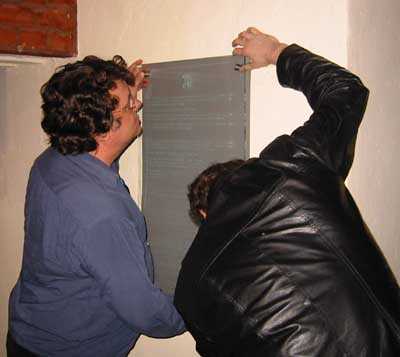 ---
---
